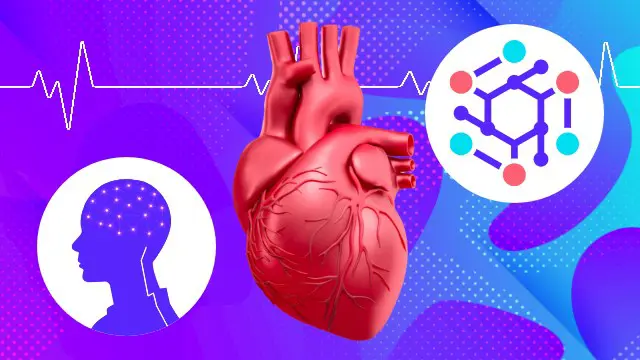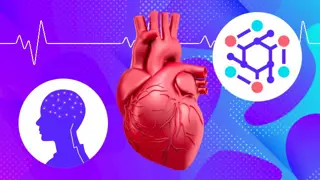
Machine Learning Project: Heart Attack Prediction Analysis
Data Science & Machine Learning - Boost your Machine Learning, statistics skills with real heart attack analysis project
Oak Academy
Summary
- Reed courses certificate of completion - Free
Add to basket or enquire
Overview
Machine Learning, python, statistics, data science, machine learning python, python data science, machine learning a-z, data scientist, r, python for data science
Hello there,
Welcome to the “ Machine Learning Project: Heart Attack Prediction Analysis” course.
Machine Learning & Data Science - Boost your Machine Learning skills with a real hands-on heart attack prediction project
Machine learning describes systems that make predictions using a model trained on real-world data. For example, let's say we want to build a system that can identify if a cat is in a picture. We first assemble many pictures to train our machine learning model. During this training phase, we feed pictures into the model, along with information about whether they contain a cat. While training, the model learns patterns in the images that are the most closely associated with cats. This model can then use the patterns learned during training to predict whether the new images that it's fed contain a cat. In this particular example, we might use a neural network to learn these patterns, but machine learning can be much simpler than that.
A machine learning course teaches you the techniques and concepts behind the predictive text, virtual assistants, and artificial intelligence. You can develop the foundational skills you need to advance to building neural networks and creating more complex functions through the Python and R programming languages. Machine learning training helps you stay ahead of new trends, technologies, and applications in this field.
We have more data than ever before. But data alone cannot tell us much about the world around us. We need to interpret the information and discover hidden patterns. This is where data science comes in. Data science uses algorithms to understand raw data. The main difference between data science and traditional data analysis is its focus on prediction. Data science seeks to find patterns in data and use those patterns to predict future data. It draws on machine learning to process large amounts of data, discover patterns, and predict trends. Data science includes preparing, analyzing, and processing data. It draws from many scientific fields, and as a science, it progresses by creating new algorithms to analyze data and validate current methods.
Data science application is an in-demand skill in many industries worldwide — including finance, transportation, education, manufacturing, human resources, and banking. Explore data science courses with Python, statistics, machine learning, and more to grow your knowledge. Get data science training if you’re into research, statistics, and analytics.
Do you know data science needs will create 11.5 million job openings by 2026?
Do you know the average salary is $100.000 for data science careers!
DATA SCIENCE CAREERS ARE SHAPING THE FUTURE
Data science experts are needed in almost every field, from government security to dating apps. Millions of businesses and government departments rely on big data to succeed and better serve their customers. So data science careers are in high demand.
-
If you want to learn one of the employer’s most requested skills?
-
If you are curious about Data Science and looking to start your self-learning journey into the world of data with Python?
-
If you are an experienced developer and looking for a landing in Data Science!
In all cases, you are at the right place!
We've designed for you " Machine Learning with Real Hearth Attack Prediction Project " a straight-forward course for the Python Programming Language and Machine Learning.
In the course, you will have a down-to-earth way explanation of the project. With this course, you will carry out a data science project from start to finish. I made it simple and easy with a real-life example.
We will open the door of the Data Science and Machine Learning world and will move deeper. You will learn the fundamentals of Machine Learning and its beautiful libraries such as Scikit Learn.
All our videos are created/produced as high-quality video and audio to provide you the best learning experience.
You will be,
-
Seeing clearly
-
Hearing clearly
-
Moving through the course without distractions
You'll also get:
Lifetime Access to The Course
Fast & Friendly Support in the Q&A section
We offer full support, answering any questions.
If you are ready to learn
Dive in now into; Machine Learning Project: Heart Attack Prediction Analysis
Data Science & Machine Learning - Boost your Machine Learning, and statistics skills with a real heart attack analysis project
See you in the course!
Curriculum
-
Course Intro 01:23
-
Introduction to Machine Learning with Real Hearth Attack Prediction Project 1:00:35
-
First Organization 23:50
-
Preparation For Exploratory Data Analysis (EDA) in Data Science 41:40
-
Exploratory Data Analysis (EDA) - Uni-variate Analysis 1:00:10
-
Exploratory Data Analysis (EDA) - Bi-variate Analysis 1:56:07
-
Preparation for Modelling in Machine Learning 1:15:16
-
Modelling for Machine Learning 1:02:03
-
Conclusion 05:32
-
Extra 01:00
Course media
Description
Machine Learning, python, statistics, data science, machine learning python, python data science, machine learning a-z, data scientist, r, python for data science
Hello there,
Welcome to the “ Machine Learning Project: Heart Attack Prediction Analysis” course.
Machine Learning & Data Science - Boost your Machine Learning skills with a real hands-on heart attack prediction project
Machine learning describes systems that make predictions using a model trained on real-world data. For example, let's say we want to build a system that can identify if a cat is in a picture. We first assemble many pictures to train our machine learning model. During this training phase, we feed pictures into the model, along with information about whether they contain a cat. While training, the model learns patterns in the images that are the most closely associated with cats. This model can then use the patterns learned during training to predict whether the new images that it's fed contain a cat. In this particular example, we might use a neural network to learn these patterns, but machine learning can be much simpler than that.
A machine learning course teaches you the techniques and concepts behind the predictive text, virtual assistants, and artificial intelligence. You can develop the foundational skills you need to advance to building neural networks and creating more complex functions through the Python and R programming languages. Machine learning training helps you stay ahead of new trends, technologies, and applications in this field.
We have more data than ever before. But data alone cannot tell us much about the world around us. We need to interpret the information and discover hidden patterns. This is where data science comes in. Data science uses algorithms to understand raw data. The main difference between data science and traditional data analysis is its focus on prediction. Data science seeks to find patterns in data and use those patterns to predict future data. It draws on machine learning to process large amounts of data, discover patterns, and predict trends. Data science includes preparing, analyzing, and processing data. It draws from many scientific fields, and as a science, it progresses by creating new algorithms to analyze data and validate current methods.
Data science application is an in-demand skill in many industries worldwide — including finance, transportation, education, manufacturing, human resources, and banking. Explore data science courses with Python, statistics, machine learning, and more to grow your knowledge. Get data science training if you’re into research, statistics, and analytics.
Do you know data science needs will create 11.5 million job openings by 2026?
Do you know the average salary is $100.000 for data science careers!
DATA SCIENCE CAREERS ARE SHAPING THE FUTURE
Data science experts are needed in almost every field, from government security to dating apps. Millions of businesses and government departments rely on big data to succeed and better serve their customers. So data science careers are in high demand.
-
If you want to learn one of the employer’s most requested skills?
-
If you are curious about Data Science and looking to start your self-learning journey into the world of data with Python?
-
If you are an experienced developer and looking for a landing in Data Science!
In all cases, you are at the right place!
We've designed for you " Machine Learning with Real Hearth Attack Prediction Project " a straight-forward course for the Python Programming Language and Machine Learning.
In the course, you will have a down-to-earth way explanation of the project. With this course, you will carry out a data science project from start to finish. I made it simple and easy with a real-life example.
We will open the door of the Data Science and Machine Learning world and will move deeper. You will learn the fundamentals of Machine Learning and its beautiful libraries such as Scikit Learn.
All our videos are created/produced as high-quality video and audio to provide you the best learning experience.
You will be,
-
Seeing clearly
-
Hearing clearly
-
Moving through the course without distractions
You'll also get:
Lifetime Access to The Course
Fast & Friendly Support in the Q&A section
We offer full support, answering any questions.
If you are ready to learn
Dive in now into; Machine Learning Project: Heart Attack Prediction Analysis
Data Science & Machine Learning - Boost your Machine Learning, and statistics skills with a real heart attack analysis project
See you in the course!
Who is this course for?
- Anyone who wants to find and publish data sets, explore and build models in a web-based data-science environment, work with other data scientists and machine learning engineers, and enter competitions to solve data science challenges.
- Those who want to compete in data science and machine learning
- Those who want to improve their CV in Data Science, Machine Learning, Python with Kaggle
- Anyone who is interested in Artificial Intelligence, Machine Learning, Deep Learning, in short Data Science
- Anyone who have a career goal in Data Science
- Anyone who needs a complete guide on how to start and continue their career with machine learning
- Students Interested in Beginning Data Science Applications in Python Environment
- Students Wants to Learn the Application of Supervised Learning (Classification) on Real Data Using Python
Requirements
- Desire to master on machine learning a-z, python, data science, statistics
- Knowledge of Python Programming Language
- Knowledge of data visualization libraries like Seaborn, Matplotlib in Python
- Knowledge of basic Machine Learning
- Be Able to Operate & Install Software On A Computer
- Free software and tools used during the course
- Determination to learn and patience.
Questions and answers
Currently there are no Q&As for this course. Be the first to ask a question.
Certificates
Reed courses certificate of completion
Digital certificate - Included
Will be downloadable when all lectures have been completed
Reviews
Currently there are no reviews for this course. Be the first to leave a review.
Legal information
This course is advertised on reed.co.uk by the Course Provider, whose terms and conditions apply. Purchases are made directly from the Course Provider, and as such, content and materials are supplied by the Course Provider directly. Reed is acting as agent and not reseller in relation to this course. Reed's only responsibility is to facilitate your payment for the course. It is your responsibility to review and agree to the Course Provider's terms and conditions and satisfy yourself as to the suitability of the course you intend to purchase. Reed will not have any responsibility for the content of the course and/or associated materials.


